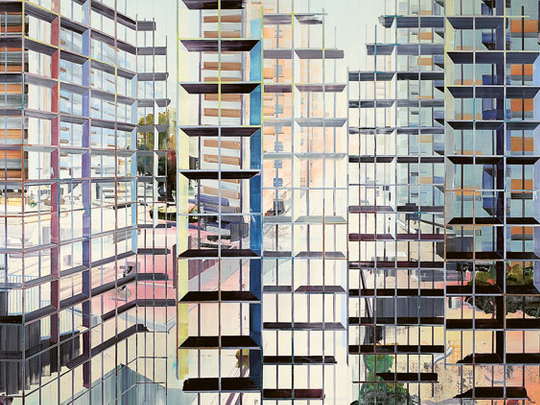
Duesseldorf-based Algerian artist Driss Ouadahi's latest work, titled Breathing Space, is part of an ongoing series that began in 2000. The series was inspired by an abandoned, incomplete block of public housing that he saw in Algiers.
"I was fascinated by the repetitive geometry of the concrete skeletons. And looking at those stark, claustrophobic spaces I could imagine the kind of life the people who were supposed to live there would lead. I felt a connection with these structures because in France and Germany, many North African immigrants live in this kind of cheap, faceless municipal housing on the outskirts of the cities," he says.
Ouadahi has woven together architectural elements and social narratives to create layered paintings that are visually appealing and charged with emotion. His cityscapes speak about the isolation, alienation and segregation in modern urban societies. Stretching right across the foreground of the paintings is the façade of the incomplete block of buildings that triggered this entire body of work. The repetitive patterns created by the criss-crossing lines of the walls have a certain rhythm and poetic beauty that is reminiscent of the geometric patterns in traditional Islamic art. But they also convey a sense of emptiness, loneliness, confinement and abandonment.
The concrete grids act as a barrier between the viewer and the architectural elements in the background. But the empty, unfinished cubicles also offer a glimpse of a bleak environment of tiny play areas and few patches of greenery squeezed in between a concrete jungle of featureless grey buildings. There are no people in these paintings, but you can feel their presence and picture their gloomy existence.
"This type of urban architecture became popular in the mid-20th century as a good solution to the problem of providing mass dwellings for the large number of migrants who came to the cities following industrialisation. The avant-garde buildings balanced form with function and could be constructed quickly and cheaply. But later, the poor quality and location of low-cost municipal housing made it a symbol of poverty, social isolation and urban decay," Ouadahi says.
That feeling of urban decay and lurking danger can be sensed in many of his paintings, such as a night scene, where the dark landscape is lit up by a burning car and a fire engine. And a painting of an underground passage that conveys the fear and insecurity one would feel in such an area. Tiny red splashes on the white-tiled walls hint at the possibility of violence, subtly indicating the atmosphere in the area.
In contrast with such depressing details, Ouadahi's landscapes also include posh buildings with shiny glass façades, tennis courts, vast open spaces, broad roads and lush greenery. This is the world on the other side of the fence. The artist often uses a fence as a symbol of exclusion and of the barriers that exist between people. In his cityscapes, the fences appear as mere impressions of a wire mesh, separating the poor areas from the posh ones. But he often paints entire canvases covered with a fence, drawn to real scale.
"Painting these fences is slow, painstaking work with a fine brush. But I enjoy it because it is like meditation," Ouadahi says. The paintings do have a meditative quality and a positive message. Because the artist always depicts the fences as breached, they become metaphors for barriers that have been broken. "People expect me to conform to stereotypes of what they believe is a north African or German style. But I have broken those barriers and combine Western aesthetics and techniques with a warm oriental palette and social themes. Similarly, there are barriers that exist between different sections of society. My broken fences and the vision of a better world on the other side of the fence offer the hope that the barriers that segregate people can be broken," he says.
Breathing Space will run at Lawrie Shabibi gallery in Dubai until March 14.











